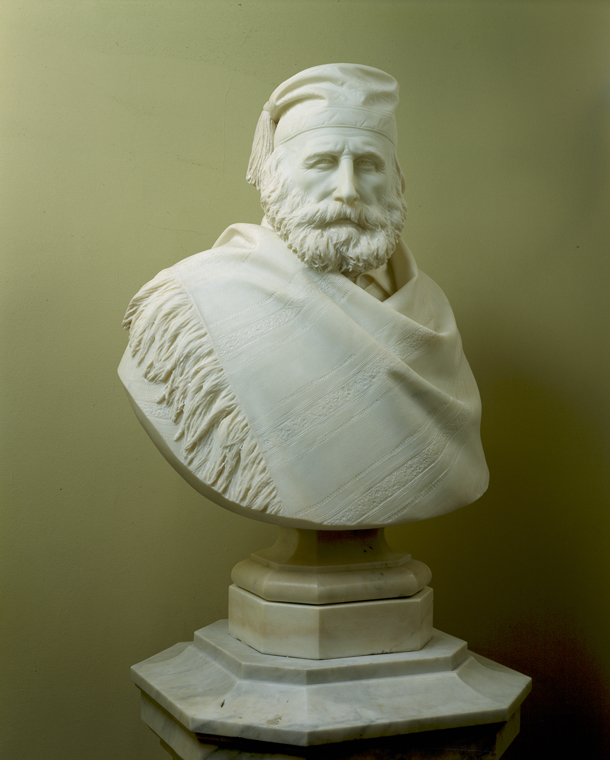
| Title | Giuseppe Garibaldi |
| Artist/Maker | Giuseppe Martegana |
| Date | 1882 ca.–1887 |
| Medium | Marble |
| Dimensions | h. 32 x w. 24.5 x d. 14 in. (h. 81.3 x w. 62.2 x d. 35.6 cm) |
| Credit Line | U.S. Senate Collection |
| Accession Number | 21.00007.000 |
After Giuseppe Garibaldi’s death in 1882, a group of Washington, D.C., residents of Italian descent formed the Society for a Monument to Garibaldi. They commissioned Giuseppe Martegana, an Italian artist living in Paris, to create a bust to commemorate the patriot. In a letter to the president of the Senate dated December 14, 1887, Dr. Tullio de Suzzara-Verdi offered the Garibaldi bust, executed in Italian marble, to the United States. He asked on behalf of the society that it be accepted “as a link in the chain of sympathy that all free men feel for the champions of liberty and popular government.” The work also was presented as an expression of Italian achievement in sculpture. On August 23, 1888, the Senate approved the acquisition, resolving that “the Senate of the United States expresses its sense of the patriotism and liberality which prompted this noble gift from these adopted citizens of Italian birth, and extends to them, the countrymen of the great champion of Italian liberty, the assurance of the admiration of the people of this land for his noble life and distinguished deeds.”
[1]
1. Congressional Record (23 August 1888) vol. 19, pt. 8: 7863.
Giuseppe Garibaldi rose from modest beginnings to become one of Italy's foremost military heroes. Born in 1807 in Nice, Garibaldi became a sailor, a merchant captain, and an officer in the Piedmont-Sardinia navy. In 1834 he fled to France after participating in an unsuccessful mutiny, fomented in part to spark a republican revolution in Piedmont-Sardinia. By 1836 Garibaldi was living in South America, where he gained fame as a revolutionary mercenary fighting in Brazil and Uruguay.
In 1848 Garibaldi set out for Italy with his band of "Redshirts." Garibaldi and his men joined the Risorgimento, a movement to unify the disparate Italian states by wresting Italian territory from foreign powers. A spirited defense of Rome against the French army in 1849 and a heroic escape from Austrian forces further increased Garibaldi's fame. His republican sympathies did not endear him to the monarchs of the Italian states, however, and Garibaldi found himself once again exiled.
Garibaldi returned to Italy in 1854, entering the service of Piedmont-Sardinia and subsequently driving the Austrians out of northern Italy. In 1860 he captured Sicily and Naples in the hope of uniting the entire peninsula under Victor Emmanuel II, the king of Piedmont-Sardinia. However, his immense popularity and republican sentiments prevented him from attaining an official role in the new kingdom of Italy, proclaimed in 1861.
Garibaldi's continued popularity and effectiveness as a military commander inspired Victor Emmanuel to turn to him repeatedly for assistance. Garibaldi headed two private expeditions against papal Rome in 1862 and 1867, and in 1866 he led an Italian army in yet another victory over the Austrians, acquiring Venice for the Italian Kingdom. After a final campaign in 1870-71, in which he assisted the French in the Franco-Prussian War, Garibaldi retired. Though crippled by rheumatism and old injuries, he was secure in his reputation as the greatest military leader of the Italian Risorgimento. He died on the island of Caprera in 1882.